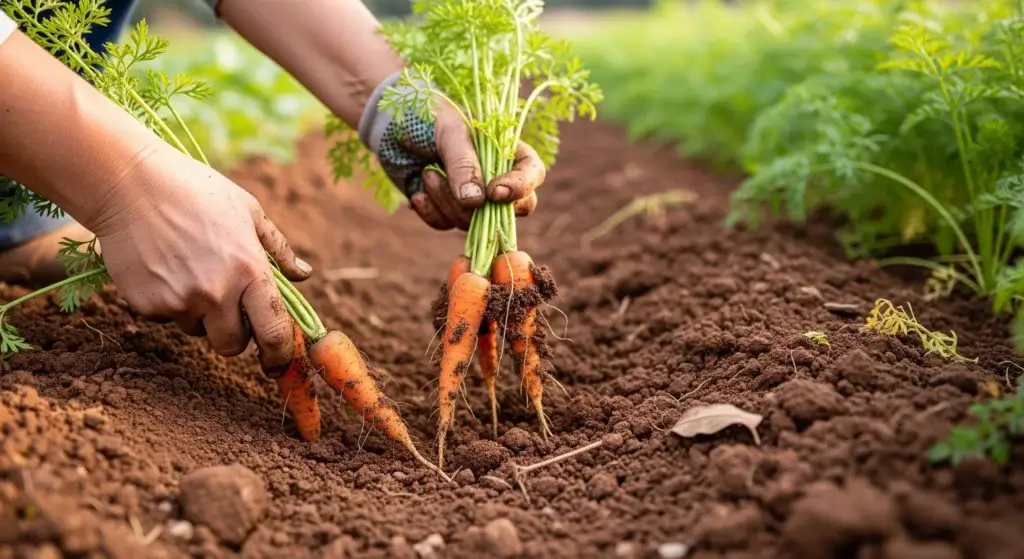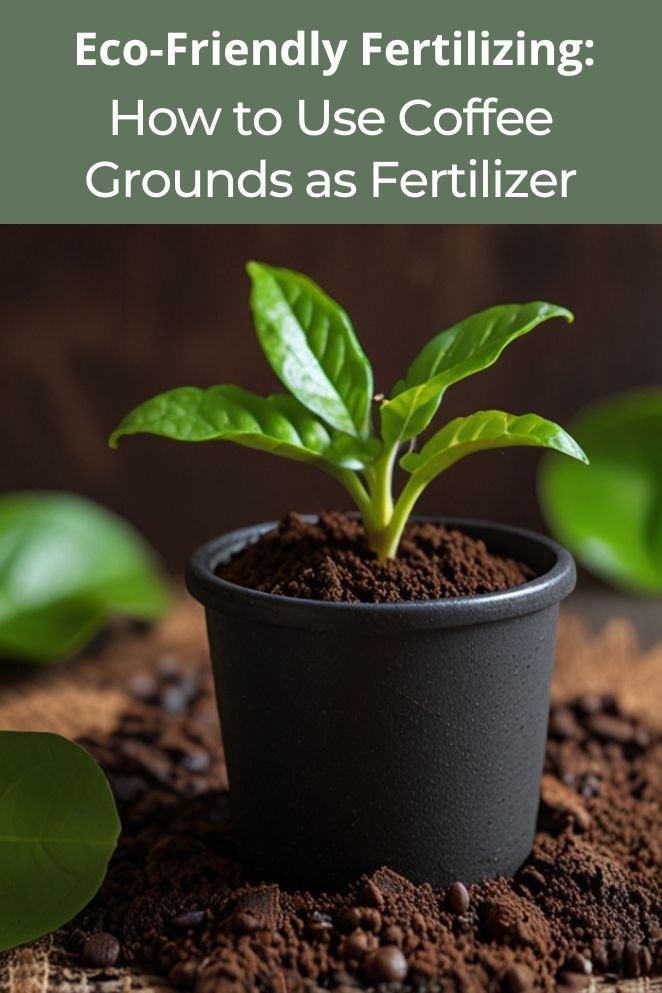
If you’re a coffee lover, you probably generate a lot of coffee grounds daily.
But did you know these leftovers from your morning brew can be a boon for your garden?
Using coffee grounds as fertilizer is an excellent way to recycle waste and boost the health of your plants.
This guide will walk you through the benefits, suitable plants, and methods to use coffee grounds effectively in your garden.
Benefits of Coffee Grounds for Plants
Coffee grounds can be a surprising ally in your gardening journey.
Used coffee grounds not only divert waste from landfills but also offer a number of benefits for your plants.
- Read also: Nurturing Beauty: A Guide to Desert Rose Fertilizer Care
- Read also: The Eggshell Hack: Eggshells as Fertilizer for Broccoli
Nutrient-rich
Coffee grounds contain essential nutrients such as nitrogen, phosphorus, and potassium.
These nutrients are crucial for plant growth and play a significant role in enhancing soil fertility, which helps plants thrive.
- Nitrogen: This is crucial for leafy growth. Nitrogen helps plants develop lush, green foliage. Coffee grounds typically contain about 2% nitrogen by volume, which is slowly released into the soil, providing a steady supply.
- Phosphorus: Important for root development and flowering. Phosphorus helps plants convert other nutrients into usable building blocks, promoting strong roots and vibrant blooms.
- Potassium: Vital for overall plant health. Potassium strengthens plants’ resilience against diseases and enhances water regulation, ensuring that plants maintain proper hydration.
Improves soil structure
Coffee grounds can significantly enhance the structure of your soil:
- Aeration: The texture of coffee grounds helps create spaces in the soil, allowing air to circulate. Good aeration is crucial for root respiration and overall plant health.
- Water retention: In sandy soils, coffee grounds improve water retention. They act like tiny sponges, holding moisture and releasing it slowly, which helps keep the soil constantly damp.
- Drainage: In clay-heavy soils, coffee grounds can improve drainage. They help break up the compact soil, preventing waterlogging and promoting better root growth.
Encourages beneficial microorganisms
Coffee grounds are a fantastic food source for beneficial microorganisms in the soil:
- Microbial activity: These microorganisms decompose organic matter, breaking it down into simpler compounds that plants can absorb. Coffee grounds provide the organic material these microbes thrive on.
- Soil health: Healthy microbial activity enhances soil fertility. Microbes convert nitrogen into forms that plants can easily use and help decompose other organic materials, enriching the soil with a broad spectrum of nutrients.
Natural pest repellent
Coffee grounds can help protect your plants from pests:
- Slugs and snails: The coarse texture of coffee grounds is unpleasant for slugs and snails to crawl over, acting as a physical barrier.
- Smell deterrent: The smell of coffee can repel other pests, such as ants and certain insects, keeping them away from your plants.
Compost booster
Adding coffee grounds to your compost pile can accelerate the decomposition process:
- Green material: Coffee grounds are considered a “green” compost material, meaning they are rich in nitrogen. This helps balance the “brown” materials like leaves and straw, which are high in carbon.
- Decomposition acceleration: The nitrogen in coffee grounds speeds up the microbial activity in your compost pile, leading to faster decomposition. This results in richer, more nutrient-dense compost.

Which Plants Can Benefit from Coffee Grounds
Coffee grounds can be a surprising ally in your gardening journey.
Used coffee grounds not only divert waste from landfills but also offer a number of benefits for your plants.
Here are some examples:
Acid-loving plants
Coffee grounds are slightly acidic, with a pH ranging from about 6.2 to 6.8.
This acidity can be beneficial for plants that prefer acidic soil conditions.
Plants like blueberries, azaleas, and rhododendrons thrive in such environments.
By adding coffee grounds to the soil, you can help lower its pH, making it more suitable for these acid-loving plants.
Other Plants
- Vegetable gardens: Many vegetables like tomatoes, carrots, and radishes can benefit from the nutrients in coffee grounds.
- Flower beds: Flowers such as roses, hydrangeas, and lilies can flourish with the extra nutrients and improved soil structure provided by coffee grounds.
- Lawns and turf: A light application of coffee grounds can help enhance the growth of your lawn.
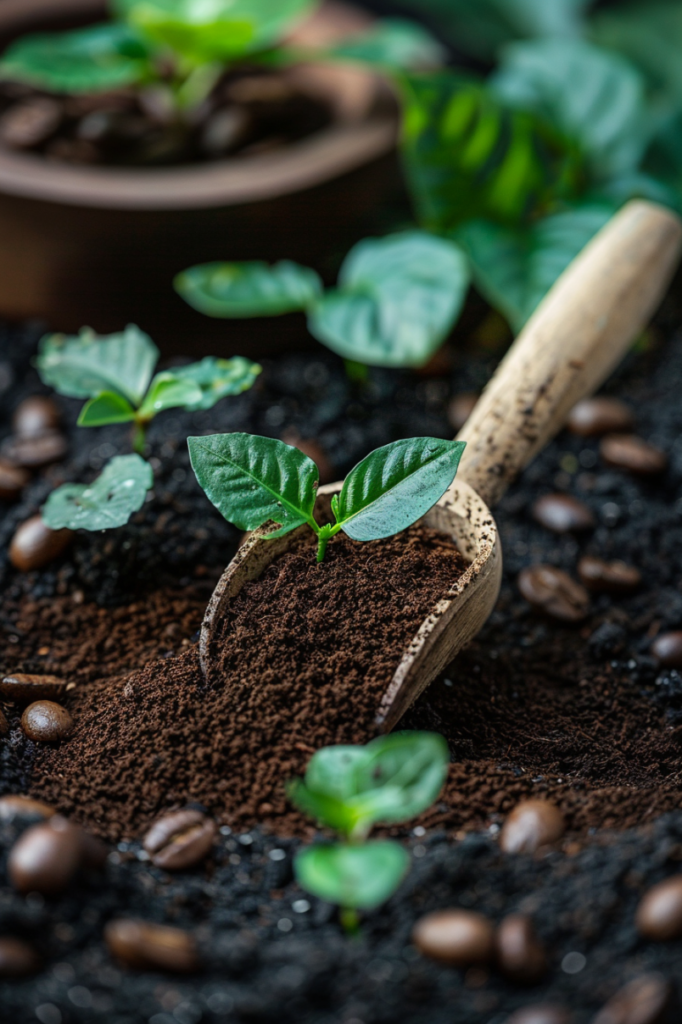
How to Use Coffee Grounds as Fertilizer
There are several ways to use coffee grounds in your garden. Let’s explore the most effective methods.
Direct application
Dry fertilizer
You can also apply coffee grounds directly to the soil around your plants:
- Sprinkling on top: Simply sprinkle a thin layer of dry coffee grounds directly onto the soil. Avoid clumping, as it can form a barrier that repels water.
- Mixing into the soil: For better integration, mix the coffee grounds into the top few inches of soil. This helps prevent any potential issues with water repellency.
However, this method requires more caution:
- Use moderation: A thin layer (no more than ½ inch) around the base of plants is sufficient. Too much can create a dense layer that hinders air and water flow.
- Target acid-loving plants: Coffee grounds’ acidity benefits plants like azaleas, blueberries, and hydrangeas [link to which plants benefit from coffee grounds section].
- Mix with other materials: To lessen acidity, consider mixing coffee grounds with eggshells or composted manure before applying them to the soil.
- Avoid new seedlings: Fresh coffee grounds can hinder seed germination, so avoid using them around newly planted seeds.
Liquid fertilizer
Coffee ground tea is a liquid fertilizer option for container plants or targeted feeding.
This “coffee ground tea” provides a gentle, nutrient-rich feed for your plants. Here’s how to make it:
- Step 1: Steep 2 cups of used coffee grounds in a gallon of water for a few hours or overnight.
- Step 2: Strain the liquid and dilute it further with water (a 1:4 ratio is recommended) before applying it to the soil around your plants. Avoid directly spraying the leaves as it could be too concentrated.
Composting with coffee grounds
This is the recommended approach for most gardeners.
Composting breaks down coffee grounds slowly, releasing nutrients gradually and reducing the risk of harming plants with excessive acidity.
Here’s how to make it:
- Step 1: Balancing green and brown materials. Coffee grounds are considered “green” compost material, meaning they are high in nitrogen. To balance this, mix them with “brown” materials like dry leaves, paper, or straw. Aim for a ratio of one part green to two parts brown.
- Step 2: Monitoring moisture and aeration. Ensure your compost pile stays moist but not soggy. Turn the pile regularly to aerate it and speed up the decomposition process.
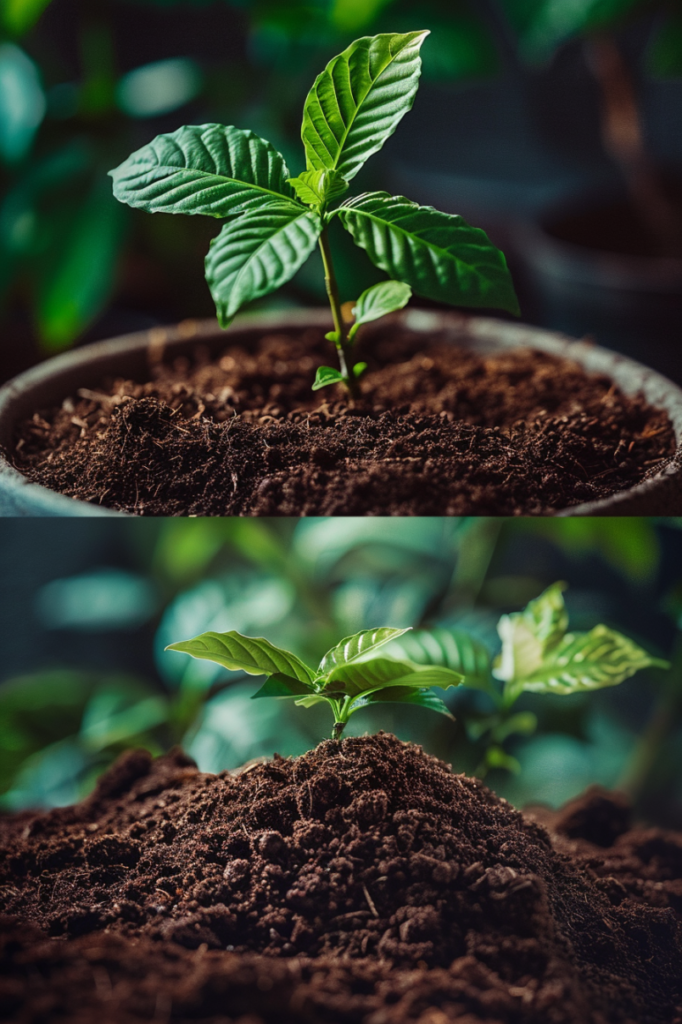
Important to Consider
While coffee grounds can be beneficial for many plants, it’s important to use them in moderation and be aware of potential drawbacks:
Too much acidity
Overuse of coffee grounds can increase the acidity of your soil too much.
This can be harmful to plants that prefer more neutral or alkaline soil conditions.
If you’re concerned about acidity, you can mix coffee grounds with a calcium-rich material like eggshells to balance the pH.
Not a complete fertilizer
While coffee grounds are beneficial for plants, they don’t contain all the essential nutrients required for optimal plant growth.
Therefore, it’s important to use coffee grounds as a supplement rather than a standalone fertilizer.
To ensure your plants receive a well-rounded diet, combine coffee grounds with a balanced fertilizer that provides the full spectrum of nutrients necessary for healthy growth.
This approach will help maintain soil fertility and promote robust plant development.
- Read also: Feeding Your Florets: The Best Natural Fertilizers for Cauliflower
- Read also: Ditch the Chemicals! Effective Natural Fertilizers For cabbage
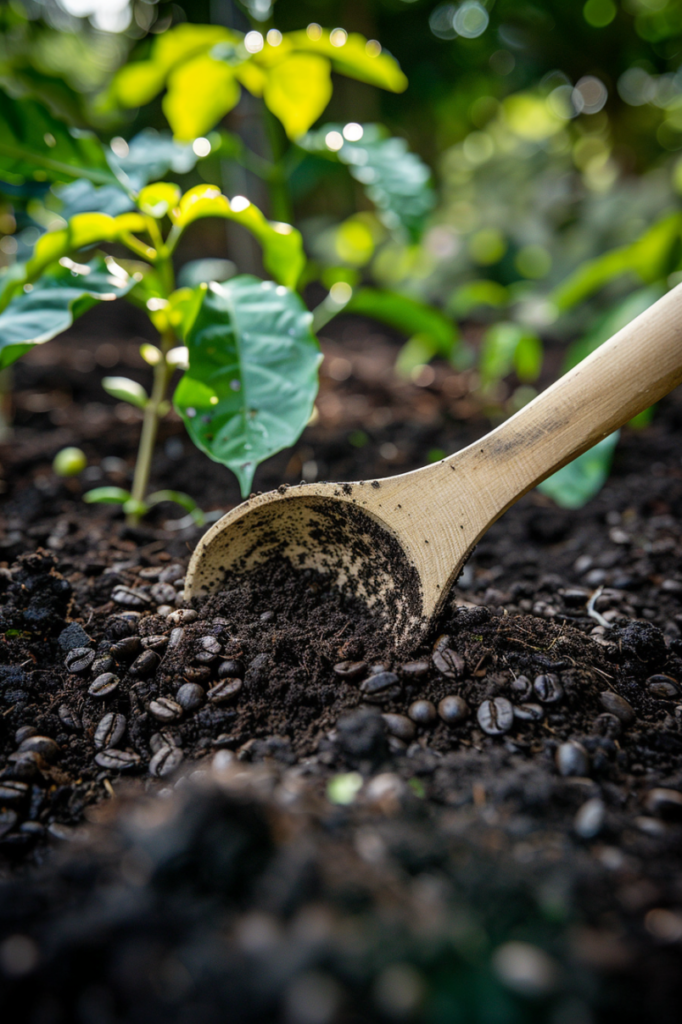
Conclusion
Using coffee grounds as fertilizer is a simple, sustainable way to enrich your garden soil and boost plant health.
Whether you use them directly, as a liquid feed, or in your compost, coffee grounds can provide numerous benefits to your plants.
Remember to use them in moderation and monitor your soil’s pH and nutrient levels for the best results.
FAQs
It’s best to use coffee grounds sparingly, adding a small amount every few weeks. Overuse can lead to soil imbalances.
While many plants can benefit from coffee grounds, avoid using them on plants that prefer neutral to alkaline soil. Always check the specific needs of your plants.
Signs of over-fertilization include yellowing leaves, stunted growth, and poor soil drainage. If you notice these symptoms, reduce the amount of coffee grounds you’re using and consider testing your soil’s pH and nutrient levels.
Yes, you can use coffee grounds from your own coffee maker or even collect them from local cafes. Just make sure they are used and not fresh, as fresh grounds are too acidic.

